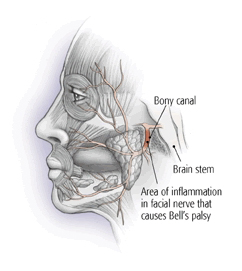
Bell’s Palsy is a disease where in muscles on one side of our face at time, causing to droop or become stiff on that side.This disease basic turns some muscles stiff.The facial nerve-also called the 7th cranial nerve-travels through a narrow, bony canal (called the Fallopian canal) in the skull, beneath the ear, to the muscles on each side of the face. For most of its journey, the nerve is encased in this bony shell.Bell’s palsy occurs when the nerve that controls the facial muscles is swollen, inflamed, or compressed, resulting in facial weakness or paralysis. Exactly what causes this damage, however, is unknown.Most scientists believe that a viral infection such as viral meningitis or the common cold sore virus herpes simplex causes the disorder.

Lubricating eye drops can help. Other therapies such as physical therapy, facial massage, or acupuncture may provide a potential small improvement in facial nerve function and pain. … It is the most common cause of facial paralysis. Generally,Bell’s palsy affects only one side of the face, but it can affect both sides.The nerve that controls your facial muscles passes through a narrow corridor of bone on its way to your face. In Bell’s palsy, that nerve becomes inflamed and swollen — usually related to a viral infection. Besides facial muscles, the nerve affects tears, saliva, taste and a small bone in the middle of your ear.
As such there no diagnosis found by the doctors but by asking the patient to move their face role or blink their eyes,lift their browse and ect.By making movement the stiff muscles are loosen up and that can help to cause the disease as such it takes a while as not medication or treatments are done yet.A diagnosis of Bell’s palsy is made based on clinical presentation — including a distorted facial appearance and the inability to move muscles on the affected side of the face — and by ruling out other possible causes of facial paralysis. There is no specific laboratory test to confirm diagnosis of the disorder.
The application of botulinum toxin to the healthy side of the face in patients with long-standing facial paralysis has been shown to be a minimally invasive technique that improves facial symmetry at rest and during facial motion, but our experience using botulinum toxin therapy for facial sequelae prompted the idea that botulinum toxin might be useful in acute cases of facial paralysis, leading to improve facial asymmetry.
To cure this disease by using transplantation you have to trance plant the whole face or else the disease cannot be cured or the exercise is supposed to be done.if a person just doesn’t want to show the society that they are going through that disease so they can go for plastic surgery but it can be risky as the toxic chemicals present in the surgery can infect the area more.